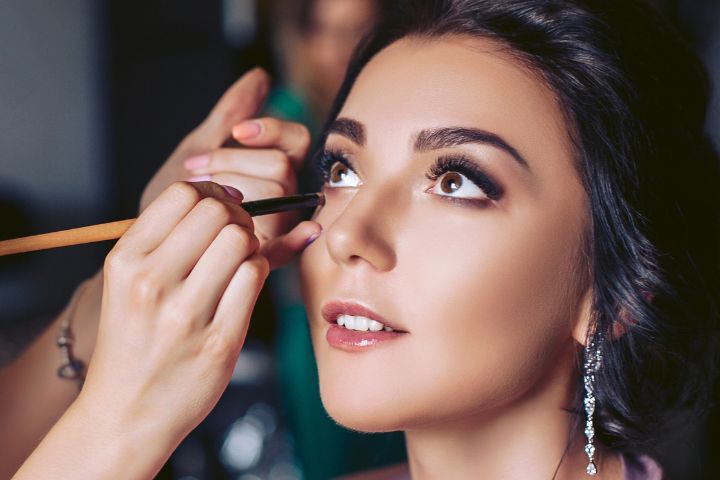The world of beauty is constantly evolving, and with new beauty trends emerging every season, the fundamentals of makeup application methods are changing with them. Whether you’re just starting out or dreaming of becoming a professional makeup artist, understanding the correct order of makeup application can make all the difference between a polished, flawless look and one that falls flat!
Are you interested in leveling up your makeup game, and wondering how to get there? Read on as we walk through the essential dos and don’ts of makeup application, from prepping your skin to avoiding common mistakes.
The do’s of professional makeup application
To create a stunning and lasting makeup look, following proper makeup application methods is key. Among the professional-approved tips to help ensure each application looks seamless and skin-loving, you should be sure to:
- Prep your skin
- Blend makeup to look seamless
- Choose the right shades for your skin type
- Focus on lighting
Do prep your skin
The foundation of every great makeup look starts long before you reach for your concealer. Skin prep is essential, and we don’t mean just a quick splash of water every night before you go to bed. Each day, you should cleanse your face thoroughly, apply toner if needed, follow up with moisturizer, and always use sunscreen or a primer that suits your skin type.
Why does this matter? Prepping your skin allows makeup to adhere better and stay on longer, while also creating a smoother canvas for foundation and concealer. Without proper prep, even the best products can cake, crease, or fade unevenly. Even more importantly, skin prep like wearing sunscreen can prevent sun damage and skin cancer, leading to a healthier blank canvas to work with when it comes time to apply makeup.
Do blend like a pro
One of the most vital makeup application methods is blending. Seamless blending takes your look from beginner to expert and involves focusing on blending of:
- Foundation
- Eyeshadow
- Blush
- Contour
The best way to create seamless blending? Use the right tools for the job: Beauty sponges, fluffy brushes, and even your fingers can all be effective, depending on the product. Work in circular motions and build slowly. Blending helps avoid harsh lines, ensuring that everything from your contour to your highlighter transitions naturally.
Do Choose the Right Shades
Makeup isn’t one-size-fits-all. A shade that flatters one person might look completely different on another due to undertone, skin type, or lighting. When selecting foundation, test it on your jawline in natural light. For eyeshadows, lipsticks, and blushes, consider your undertone (cool, warm, or neutral) to choose complementary shades. If you don’t know what your skin undertone is, you can ask a professional at a makeup counter or you can enroll in a beauty training program to learn these skills and more.
This step is crucial in professional makeup artistry. Using the right shades for your skin tone (or for your clients) can dramatically enhance the final result.
Do Focus on Lighting
Lighting can make or break your makeup application order. Always apply makeup in good, natural lighting when possible. Poor lighting can lead to:
- Uneven foundation
- Mismatched colors
- Over-application
For makeup artists or students in training, investing in a ring light or mirror with adjustable settings can help simulate different lighting environments and help you adjust your techniques accordingly.
The don’ts of professional makeup application
Now that we’ve covered what you should do, let’s talk about the habits and mistakes to avoid. When it comes to applying makeup like a pro, here are some things not to do:
- Don’t skip skincare
- Don’t overdo it on product
- Don’t forget to sanitize your tools
- Don’t neglect to practice your skills
Don’t skip skincare
If you think you can skip your skincare routine and still expect flawless results, think again. Makeup can only do so much, as healthy skin is the real foundation.
Skipping moisturizer or eye cream can result in dry patches, creasing, or even breakouts. A lack of hydration also prevents products like concealer and foundation from blending smoothly, which can make your skin appear textured or dull. Daily skincare can be a fun part of self-care, so be sure to take the time to identify what your skin needs and create a habit that lasts!
Don’t overdo it on product
More isn’t always better. One of the most common mistakes in makeup applications is using too much product. This applies to all parts of makeup application, including:
- Foundation
- Contour
- Eyeshadow
- Highlighter
- Eyebrows
- Blush
Heavy layers can weigh down the skin and make the makeup look cakey, especially if you don’t blend well. Instead, apply thin layers and build coverage only where necessary. This gives a more natural, professional finish.
Don’t forget to sanitize tools
This is a big one, especially if you’re working with clients. Dirty brushes and sponges can harbor bacteria that may lead to breakouts or infections.
Regularly clean your tools using a gentle brush cleanser or soap. For professionals or students in training, sanitization is a key part of hygienic practices that reflect industry standards.
Don’t neglect practice
Mastering the order of makeup application takes time, patience, and a lot of repetition. Don’t get discouraged if your eyeliner isn’t perfectly winged or your contour looks uneven. Every expert started as a beginner!
Practice consistently and study the techniques used by top beauty professionals. Watch tutorials, attend workshops, or even better—enroll in a beauty training program that gives you hands-on experience.
Learn all these steps and more in a beauty training program
While learning tips and tricks online is helpful, nothing replaces the value of structured education and guided practice. At Dorsey College, our beauty programs are designed to equip students with the skills, techniques, and knowledge to succeed in the world of beauty.
In our training programs, you can learn about a variety of topics – not just the makeup application order, and also how to adapt makeup techniques for different face shapes, skin types, and occasions. From bridal to daily makeup trends, you can build a diverse skill set that aligns with today’s hottest beauty styles.
Our experienced instructors bring real-world expertise into the classroom, helping students build confidence and sharpen their artistry. You can also gain insight into:
- Client communication
- Hygiene and sanitization practices
- Color theory
- Product knowledge
- And more!
If you’re passionate about beauty and want to make it your career, Dorsey College is here to help turn your dream into reality. Whether you aspire to work in a salon, backstage at fashion shows, or run your own freelance makeup business, your journey starts with the right education. Contact us today for more information or to schedule a campus visit.
Dorsey School of Beauty, located in Taylor, MI, is a sister school of Dorsey College. Dorsey School of Beauty in Taylor, MI is accredited by the National Accrediting Commission of Career Arts & Sciences (NACCAS). To learn more about Dorsey School of Beauty in Taylor, MI you can click here.
Dorsey College and Dorsey School of Beauty have determined that their Cosmetology, Manicuring, and Esthetician program curriculums are sufficient to fulfill educational requirements for licensure in the State of Michigan only, for the respective field. No academic determinations have been made for any other state, district, or US territory regarding licensure requirements.

